Hybrid model boosts Tucson over competition
Filed under: Weekly test drives, Autos
By John Gilbert
For exactly a decade, Hyundai has surged from being a South Korean interloper on the automotive scene to becoming a surprising competitor and then a superior product for solid quality, technology and fuel efficiency all at once, in both its cars and its SUVs. It was the 2011 model year when the Sonata was totally redone to ignite Hyundai into the future. The new Sonata and Elantra now lead the way for Hyundai sedans, while the large Palisade and the compact Kona have set high standards, large and small, for SUVs.
A year ago, Hyundai redesigned its Santa Fe, the midsize SUV entry, leaving only the Tucson in need of renewal. That renewal is happening right now. The redesign is outstanding, and thrusts the Tucson as a 2022 model up into the heady atmosphere dominated by the RAV4, CR-V, Rogue and CX-5 — the outstanding entries from Toyota, Honda, Nissan, and Mazda, respectively, Japan’s top vehicles.
Just being clustered with those four is a high achievement, but the Tucson is more than that, despite what the evaluators at Motor Trend might suggest. In its latest issue, Motor Trend compared the Tucson with the CR-V, RAV4 and Rogue in a recent issue, and ranked the CR-V first, but apparently figured readers wouldn’t notice that the RAV4, Rogue and Tucson all were equipped with competitive 2.5-liter 4-cylinder engines, while the CR-V had a 1.5-liter turbocharged 4 — and with the advantage of the only turbo engine, it ran away with the performance categories.
Turbochargers can do that for a smaller, higher-revving engine. To be fair, however, the magazine could have tested the Tucson model I drove, which was the “Ultimate,” and came with a turbo 1.6 engine, plus a hybrid setup with a battery pack stashed under the back seat. Frankly, I like all of those other vehicles, and the Mazda CX-5, as well, but switching to the zippier 1.6 turbo in the Tucson would have put it on equal performance footing with the CR-V, and adding the hybrid technology vaults it above and beyond that elite group.
The 1.6 turbo has a strong-enough 180 horsepower, and adding the 44.2 kW electric motor adds 59 horsepower from 1,600-2,000 RPMs, and boosts the Tucson to a combined 226 horsepower and 195 foot-pounds of torque. The point where the torque, or power, hits its peak is all-important to performance, and the Tucson Hybrid’s toque peaks at 0 RPMs — zero — and stays at that peak up to 1,500 revs. The LG Chem battery pack is a 270-volt Lithium-ion polymer. unit that rests flat on the floor, under the rear seat, which also gives the Tucson a mid-engine weight characteristic.
Under the skin, the Tucson is 182.3 inches long with a 108.5 inch wheelbase and weighs 3,762 pounds with all-wheel drive. Independent front and rear suspension uses MacPherson struts in the front and a multilink set-up at the rear. A big reason for the solid feel to the Tucson is the rigidity of the platform, plus the body-strength that comes from a high dose of high-strength steel and high-tensile steel from Hyundai’s own steel plant.
The new Tucson is a 2022 model, and while it borrows from the classy Palisade, and the Santa Fe, I think it steps boldly ahead to establish a new face for Hyundai. But while discussing performance, I must point out that in a week’s time driving up and down the North Shore of Lake Superior, and scaling and descending the steep hills of Duluth, Minnesota, I found the performance was not only outstanding in the Tucson, but the fuel economy went off the scale. Read more
BMW engine boosts Supra to new Toyota image
Filed under: Weekly test drives, Autos, Uncategorized
By John Gilbert
The idea that folks at Toyota are going through a “second childhood” takes root from the fact that the Japanese auto giant has hit the market with several sports coupes, convertibles and racy vehicles in the last few years. The upscale Lexus LC500 was the subject of my review here just a few weeks ago, as the 6-figure pinnacle of luxury-performance, and now, before October gets far enough along to threaten us with some foul weather, we’ve got to also check out the 2021 Toyota Supra and declare it the company’s bargain luxury-sports car.
Actually, the bargain sports car of the Toyota line is the unfortunately-named Toyota 86, an under-$30,000 sports car built jointly with Subaru, using Subaru engines, and almost identical to the Subaru BRZ.
The new Supra is a completely different story. If working a jont-venture with Subaru was a good idea for a low-slung sports car, then working the magic combination with BMW to come up with the Supra is even better, and a mid-$50,000 price point is a comparative bargain when you know you’ve got the same 3.0-liter inline 6 made by BMW for its new M4 sporty coupe.
The Supra is a grand old name in Toyota lore, starting as a stretched out luxury model of the Celica coupe three decades ago, and it persisted as a powerful sporty cruiser with a potent Toyota in-line 6 and all of the company’s advancing technology. Toyota even stretched the Supra out into a “2 plus 2” model with a jump-seat behind the two buckets.
Times change, and with its new upscale Lexus brand also needing vehicles, the Supra disappeared from the U.S. market just over 20 years ago. Toyota now is on a movement to shed its stodgy, conservative image, and after its Lexus sports cars and sportier leaning of Toyotas, the company brought back the Supra name on an exotic-looking new sports coupe as the fifth-generation Supra for 2020.
The look of the Supra didn’t dazzle men when it first came out for 2020. I knew it was something of a composite vehicle jointly created by Toyota and BMW, giving it legendary heritage from two international automotive legends. But it had this extra-prominent nose that I thought made it look, well…ugly.
Anyhow, after a few slight revisions, a 2021 model of the Supra showed up for me to test drive, up and down the North Shore of Lake Superior in mid-September, just before the leaves were turning color, and it was a pure, bright red attention-grabber. So, too, were the grooves and scoops and contours that pretty well obscured the nose. The nose! What happened to the nose? The prominent beak was modified to the point its nose is no longer is objectionable, in my humble opinion, and you can judge for yourself from the accompanying photos.
Similar in size and intention to the LC55 Lexus, which cost somewhere north of six figures, I was pleasantly surprised to find the Supra was more like the mid-$52,000 range, which is definitely a bargain, by comparison.
Under the hood is a 3.0-liter inline 6, which could have been built by Toyota in the old days, but is built by BMW today, and certainly not a bad choice. Traditional sports car buyers will appreciate the rear-drive platform, although I could foresee all-wheel drive in the future.
This twin-turbocharged 6 delivers 382 horsepower and 368 foot-pounds of torque through an 8-speed transmission, directly to the rear wheels. The car handles with great precision, with a platform also from BMW’s engineers. You can play with the drive mode switch and get into sports settings that heighten the stiffness and the tightness of the steering and suspension, and turns the exhaust from mellow to raucous. Read more
CX-30 perfect fit in Mazda’s SUV lineup
Filed under: Weekly test drives, Autos
By John Gilbert
The unprecedented summer dryspell slowed the streams to a trickle and had the effect of diminishing the usual dramatic change in foliage colors along the North Shore of Lake Superior. That point was driven home to me when I had the chance to test drive a 2021 Mazda CX-30 for a pre-autumn week, and the faintness of the leaves’ color was dramatized by the vividness of the familiar Mazda color of “Crystal Soul Red Metallic.”
Without question, I am a devoted follower of the brilliant technology that has gone into Mazda vehicles, especially in the last couple of decades. While remaining a small player world automotive competition, Mazda turns loose its engineers and designers to ,ake every vehicle a creative endeavor. The result usually is to upgrade the Mazda fleet into world-class vehicles with amazing technology under the skin.
The CX-30 is an example of how Mazda governs itself. The Hiroshima company seemed to have things in order with two sedans — the Mazda3 compact and the Mazda6, a sporty and luxurious intermediate with full-size room — and three SUVs, the CX-3 subcompact, the CX-5 midsize, and the CX-9 near-full-size. with three rows. The CX-5 was just right, with adequate rear seat room and stowage space, and the heart of a performance vehicle.
The CX-3, however, was just plain too small. Only very small children could fit in the rear seat if the front buckets were in normal position, although it might have been the perfect agile SUV for a single driver.
Mazda went back to the drawing board and hustled up its next generation to solve the issue. The plan is to rename those SUVs, with the CX-3 being scratched and replaced by a new vehicle — the CX-30, with significantly more room than the CX-3, but not quite up to CX-5 dimensions. Obviously the plaviouslyn calls for a new CX-5, slightly enlarged to make more room for the CX-30, and it will be called the CX-50, and a new CX-90 will follow to replace the CX-9. Read more
Compact GLA 250 packs Mercedes punch
Filed under: Weekly test drives, Autos
By John Gilbert
The classic stature of Mercedes Benz automobiles runs all the way back to the company’s origin, in the late 1800s. You could say it runs back to when Daimler and Benz first met, except one of the wonderful legends of the company is that the two built competing vehicles and they never did meet, despite dwelling only a few miles apart. The incorporating of the two came after both pioneers had died, and it’s safe to say that while both had visions of what a motorized carriage could be, undoubtedly neither could have envisioned the evolution of cars to today’s standards.
To say nothing of trucks.
While Mercedes cars retain the iconic nature of the ultimate luxury sedans, the always-expanding array of Mercedes SUVs is just as iconic, from the largest all-terrain and luxury family haulers to the most compact. As it turns out, after being completely impressed with all the SUVs, by personal favorite comes down to the GLA250 — a compact but fully capable vehicle that will do anything its owner might bid it to do.
While spending a week with a 2021 model GLA250 4Matic SUV, we put it through its family-hauler paces on the hills of Duluth, Minnesota, as well as a pleasant trip up Lake Superior’s North Shore on the legendary Hwy. 61 up to Grand Marais, a pleasant destination that gets close to the Canadian Border but provides an artsy stop with shops, restaurants, and that One Particular Harbor protecting the sailboat landings from the sometimes temperamental Lake Superior. That is the perfect setting for a destination drive as well as some hiking trails both in and near town. Read more
LC500 dazzles from looks, power, to top
Filed under: Weekly test drives, Autos
By John Gilbert
If you were buying a car and could only pick one, would you prefer a high-performance sports car with exceptional power and handling, or a stunning, great-looking sports car that freezes passersby in their tracks every time you drive past?
The answer, of course, is both. And both are readily attainable — for a price. The provider of this spectacular vehicle that combines such mind-blowing attributes is Toyota. Surprised?
Known almost exclusively for steady, durable and intelligent engines and vehicles, Toyota has made inroads into the higher-performance segments in the last couple of years, mostly through its upscale Lexus nameplate. They’ve struck paydirt, with the 2021 Lexus LC500.
That badge has been the ultimate, for Lexus, and the plateau of excellence has been raised on several counts with the 2021 L:C500.
First, beautiful as a coupe, for this year, it’s a convertible. The LC500 is great looking with the top up, as a coupe, but it goes from attractive to spectacular with the holding of a concealed console switch that executes a mechanical coordination of erector-set inner parts, which raise the rear deck, lift off the sleek roof, and nestle it down into the rear compartment before uncoiling the mechanical routine and latching the decklid over the whole thing. It takes about 12 seconds for the process, which means you can easily put the top down at a stoplight. More importantly, if you’ve been driving top-down and avoiding the threat of rain sprinkles, you can put the top back up at the next stoplight in the same brief mechanical flurry to keep you dry.
The test LC500 came in “Infrared,” a sizzling metallic red that reflects every meaningful bit of light back at your receptive eyes. Somehow, convertibles look better in red, and red looks better in Infrared. Read more


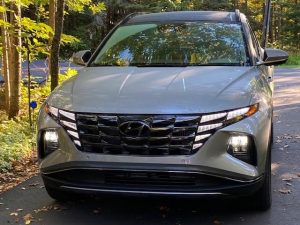
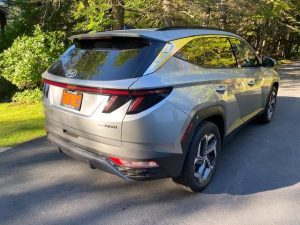
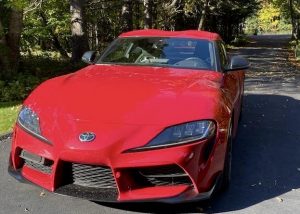
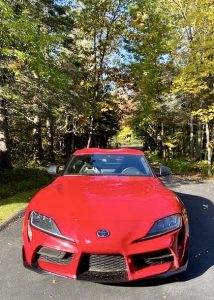
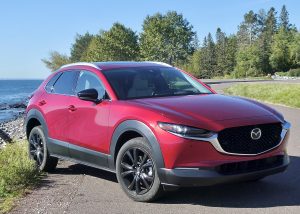
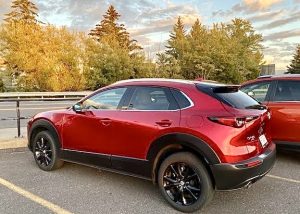
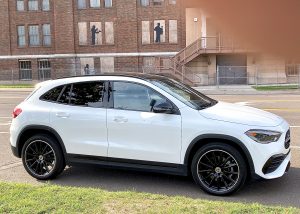
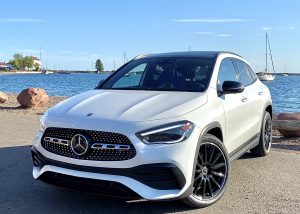
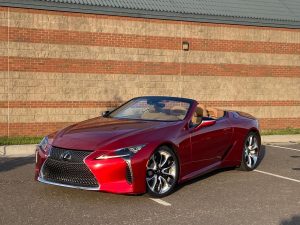
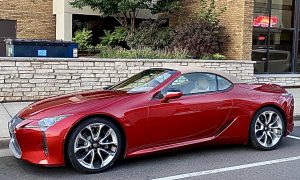
 John Gilbert is a lifetime Minnesotan and career journalist, specializing in cars and sports during and since spending 30 years at the Minneapolis Tribune, now the Star Tribune. More recently, he has continued translating the high-tech world of autos and sharing his passionate insights as a freelance writer/photographer/broadcaster. A member of the prestigious North American Car and Truck of the Year jury since 1993. John can be heard Monday-Friday from 9-11am on 610 KDAL(www.kdal610.com) on the "John Gilbert Show," and writes a column in the Duluth Reader.
John Gilbert is a lifetime Minnesotan and career journalist, specializing in cars and sports during and since spending 30 years at the Minneapolis Tribune, now the Star Tribune. More recently, he has continued translating the high-tech world of autos and sharing his passionate insights as a freelance writer/photographer/broadcaster. A member of the prestigious North American Car and Truck of the Year jury since 1993. John can be heard Monday-Friday from 9-11am on 610 KDAL(www.kdal610.com) on the "John Gilbert Show," and writes a column in the Duluth Reader.